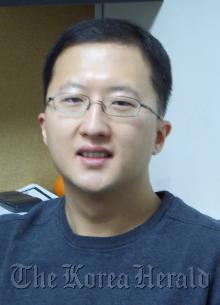KAIST team uses nanotech to solve vehicle battery problem
By Park Hyung-kiPublished : Dec. 2, 2012 - 20:21

Korean scientists have discovered a way to improve the energy output and lifecycle of lithium-ion batteries by applying nanotechnology in the development of lithium manganese oxide for use in cathodes.
The materials have been studied over the years as an alternative to lithium cobalt oxide to boost power and life expectancy of rechargeable batteries for electric vehicles.
However, the dissolution of manganese during the chemical reaction process to create the compound has shortened the life cycle of lithium-ion batteries.
A team of scientists and researchers led by professor Choi Jang-wook at Korea Advanced Institute of Science and Technology’s Graduate School of Energy, Environment, Water and Sustainability have found a way to deter manganese dissolution.
It said that the team was able to realign the atoms in the crystal structure of lithium manganese oxide by applying nano materials, which were able to boost the activity of both manganese and lithium-ion chemical elements.
This process led secondary batteries to generate five times as much power as existing batteries with lithium cobalt oxides, and have three times their life expectancy.
Lithium cobalt materials had been widely used in lithium-ion batteries, but were expensive, toxic and had a short rechargeable cycle for electric vehicles, which required high electric current density to be as fast and powerful as gasoline-fueled automobiles.
The latest discovery in lithium manganese oxide cathode materials, which are safer, cheaper and more eco-friendly, can boost the acceleration of electric vehicles. It could also can be applied to smart grids in the near future, the team said.
Lithium-ion batteries for electric vehicles have been receiving attention as countries worldwide adopt environmentally-friendly policies.
They offer the possibility of cutting greenhouse gas emissions.
However, electric vehicles have failed to attract consumer attention worldwide, being not as powerful as gasoline-fueled automobiles.
Another downside is that it takes as long as 30 minutes to recharge EV batteries, while filling up with gas takes just a couple of minutes. Also, replacing EV batteries is extremely expensive, making them less economical than purchasing conventional cars in the long-term, experts said.
The development of cathode materials by KAIST could open the way to further improve the efficiency of EVs and smart grids.
Korea is aiming to develop smart grid infrastructure linking power distribution, power grids and plants such as solar, wind and tidal, households and EVs for electric consumption efficiency and carbon mitigation by 2030. The country is currently testing smart grid technology in Jeju.
Professor Choi said that the team had already filed and secured patents both at home and abroad, and plans to commercialize the materials application in collaboration with businesses within two to three years.
Choi’s research was published in the Nano Letters journal last week.
By Park Hyong-ki (hkp@heraldcorp.com)
The materials have been studied over the years as an alternative to lithium cobalt oxide to boost power and life expectancy of rechargeable batteries for electric vehicles.
However, the dissolution of manganese during the chemical reaction process to create the compound has shortened the life cycle of lithium-ion batteries.
A team of scientists and researchers led by professor Choi Jang-wook at Korea Advanced Institute of Science and Technology’s Graduate School of Energy, Environment, Water and Sustainability have found a way to deter manganese dissolution.
It said that the team was able to realign the atoms in the crystal structure of lithium manganese oxide by applying nano materials, which were able to boost the activity of both manganese and lithium-ion chemical elements.
This process led secondary batteries to generate five times as much power as existing batteries with lithium cobalt oxides, and have three times their life expectancy.
Lithium cobalt materials had been widely used in lithium-ion batteries, but were expensive, toxic and had a short rechargeable cycle for electric vehicles, which required high electric current density to be as fast and powerful as gasoline-fueled automobiles.
The latest discovery in lithium manganese oxide cathode materials, which are safer, cheaper and more eco-friendly, can boost the acceleration of electric vehicles. It could also can be applied to smart grids in the near future, the team said.
Lithium-ion batteries for electric vehicles have been receiving attention as countries worldwide adopt environmentally-friendly policies.
They offer the possibility of cutting greenhouse gas emissions.
However, electric vehicles have failed to attract consumer attention worldwide, being not as powerful as gasoline-fueled automobiles.
Another downside is that it takes as long as 30 minutes to recharge EV batteries, while filling up with gas takes just a couple of minutes. Also, replacing EV batteries is extremely expensive, making them less economical than purchasing conventional cars in the long-term, experts said.
The development of cathode materials by KAIST could open the way to further improve the efficiency of EVs and smart grids.
Korea is aiming to develop smart grid infrastructure linking power distribution, power grids and plants such as solar, wind and tidal, households and EVs for electric consumption efficiency and carbon mitigation by 2030. The country is currently testing smart grid technology in Jeju.
Professor Choi said that the team had already filed and secured patents both at home and abroad, and plans to commercialize the materials application in collaboration with businesses within two to three years.
Choi’s research was published in the Nano Letters journal last week.
By Park Hyong-ki (hkp@heraldcorp.com)





![[Herald Interview] 'Amid aging population, Korea to invite more young professionals from overseas'](http://res.heraldm.com/phpwas/restmb_idxmake.php?idx=644&simg=/content/image/2024/04/24/20240424050844_0.jpg&u=20240424200058)











![[KH Explains] Korean shipbuilding stocks rally: Real growth or bubble?](http://res.heraldm.com/phpwas/restmb_idxmake.php?idx=652&simg=/content/image/2024/04/25/20240425050656_0.jpg&u=)

